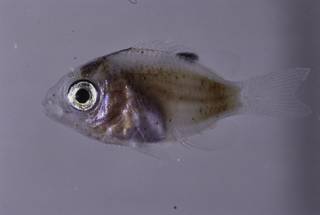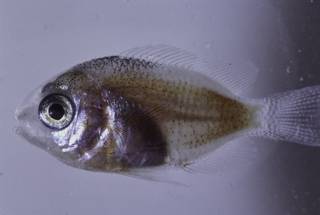
| Intro | | Search taxa | | Browse taxa | | Distributions | | Terminology | | References | | Statistics | | Online sources | | Tutorial | | Log in |
WoRMS taxon detailsPomacentridae Bonaparte, 1831
marine, brackish, fresh,
Not documented
Description Chiefly marine; rare in brackish water. All tropical seas, mainly Indo-Pacific. One nostril on each side of head; double...
Description Chiefly marine; rare in brackish water. All tropical seas, mainly Indo-Pacific. One nostril on each side of head; double nostrils in some species of Chromis and Dascyllus. Body usually deep and compressed. Small mouth. Incomplete and interrupted lateral line. Anal fin with usually 2 spines, very rarely 3. No palatine teeth. About 35 cm maximum length. Coloration variable with individuals and with locality for the same species. Many species are highly territorial herbivores or omnivores. Damselfishes lay elliptical demersal eggs that are guarded by the males. Included are the anemonefishes (Amphiprioninae), which live in close association with large sea anemones. Poma- = opercle, centron = spine, (refers to pointed margin of opercle); amphi- (gr.) = on both sides, prion = saw, (refers to serrate opercles) [details]
Froese, R. and D. Pauly. Editors. (2024). FishBase. Pomacentridae Bonaparte, 1831. Accessed through: World Register of Marine Species at: https://www.marinespecies.org/aphia.php?p=taxdetails&id=125553 on 2024-11-07
Date action by
taxonomy source
Van Der Laan, R.; Eschmeyer, W. N.; Fricke, R. (2014). Family-group names of Recent fishes. <em>Zootaxa.</em> 3882(1): 1-230., available online at https://doi.org/10.11646/zootaxa.3882.1.1 [details] Available for editors
context source (PeRMS) Chirichigno, N.; Cornejo, M. (2001). Catálogo comentado de los peces marinos del Perú. <em>2ª ed. Instituto del Mar de Perú. Publicación Especial. Callao.</em> 314 p. [details] basis of record van der Land, J.; Costello, M.J.; Zavodnik, D.; Santos, R.S.; Porteiro, F.M.; Bailly, N.; Eschmeyer, W.N.; Froese, R. (2001). Pisces, <B><I>in</I></B>: Costello, M.J. <i>et al.</i> (Ed.) (2001). <i>European register of marine species: a check-list of the marine species in Europe and a bibliography of guides to their identification. Collection Patrimoines Naturels,</i> 50: pp. 357-374 (look up in IMIS) [details] additional source Fricke, R., Eschmeyer, W. N. & Van der Laan, R. (eds). (2024). ECoF. Eschmeyer's Catalog of Fishes: Genera, Species, References. <em>California Academy of Sciences. San Francisco.</em> Electronic version accessed dd mmm 2024., available online at http://researcharchive.calacademy.org/research/Ichthyology/catalog/fishcatmain.asp [details]  Present Present  Inaccurate Inaccurate  Introduced: alien Introduced: alien  Containing type locality Containing type locality
Unreviewed
Description Chiefly marine; rare in brackish water. All tropical seas, mainly Indo-Pacific. One nostril on each side of head; double nostrils in some species of Chromis and Dascyllus. Body usually deep and compressed. Small mouth. Incomplete and interrupted lateral line. Anal fin with usually 2 spines, very rarely 3. No palatine teeth. About 35 cm maximum length. Coloration variable with individuals and with locality for the same species. Many species are highly territorial herbivores or omnivores. Damselfishes lay elliptical demersal eggs that are guarded by the males. Included are the anemonefishes (Amphiprioninae), which live in close association with large sea anemones. Poma- = opercle, centron = spine, (refers to pointed margin of opercle); amphi- (gr.) = on both sides, prion = saw, (refers to serrate opercles) [details]
|


